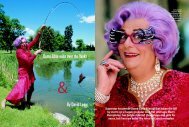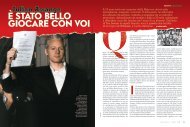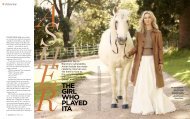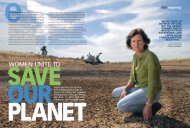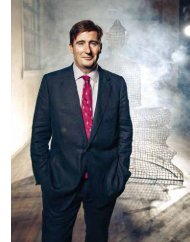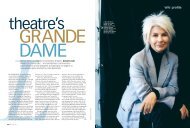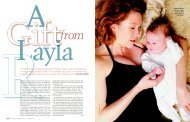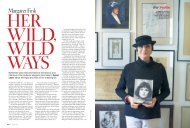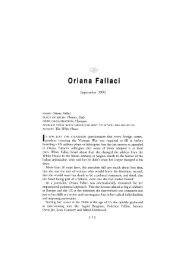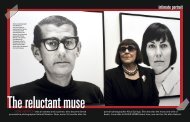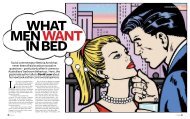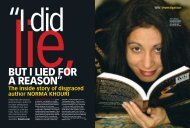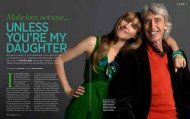The art and life of - David Leser
The art and life of - David Leser
The art and life of - David Leser
You also want an ePaper? Increase the reach of your titles
YUMPU automatically turns print PDFs into web optimized ePapers that Google loves.
INGVAR KENNE. FAIRFAX. Judy<br />
Famed for her vivid portraits <strong>and</strong> major <strong>art</strong><br />
awards – including two Archibald Prizes –<br />
Judy Cassab has survived Nazi persecution,<br />
poverty <strong>and</strong> enjoyed a great, enduring love.<br />
Here, <strong>David</strong> <strong>Leser</strong> reveals her amazing story.<br />
<strong>The</strong> <strong>art</strong> <strong>and</strong> <strong>life</strong> <strong>of</strong><br />
Cassab<br />
It is easy to be forgotten. In this culture <strong>of</strong> ours that<br />
swoons on celebrity <strong>and</strong> youth, one might simply let<br />
the <strong>life</strong> <strong>and</strong> work <strong>of</strong> someone like Judy Cassab fade<br />
from view. A delightful woman with a prodigious<br />
talent <strong>and</strong> an epic story <strong>of</strong> love <strong>and</strong> survival to match<br />
might just be confined to the margins, to live out her<br />
days without remark, much less celebration.<br />
That would be a shame. Ap<strong>art</strong> from failing to honour an<br />
<strong>art</strong>ist <strong>and</strong> her work, it would deny us the chance to recall<br />
some <strong>of</strong> our own European history, given that in Judy<br />
Cassab’s story we are reminded not just <strong>of</strong> the horrors<br />
which befell so many <strong>of</strong> our parents <strong>and</strong> gr<strong>and</strong>parents, but<br />
also <strong>of</strong> the kind <strong>of</strong> country this was in the 1950s, when<br />
everything seemed barren <strong>and</strong> upside down, but where a<br />
haunting beauty awaited the receptive eye, p<strong>art</strong>icularly<br />
the eye <strong>of</strong> an <strong>art</strong>ist.<br />
But somehow fate or a “higher power” – as Judy<br />
Cassab might like to call it – has intervened so that now,<br />
nearly 40 years after first winning the Archibald Prize<br />
(she has won it twice, in 1961 <strong>and</strong> 1968), <strong>and</strong> nearly 50<br />
years after winning <strong>The</strong> Australian Women’s Weekly<br />
portrait prize (she won it two years in a row, 1955 <strong>and</strong><br />
1956) we are again able to gaze at the rich canvas <strong>of</strong> a<br />
work <strong>and</strong> <strong>life</strong> still in progress.<br />
In some ways we have her elder son, John Seed, a<br />
heroic figure in the international environment movement,<br />
to thank for that. “Can I be your agent?” he asked his<br />
83-year-old mother recently, out <strong>of</strong> the blue, after a<br />
<strong>life</strong>time <strong>of</strong> having virtually ignored her work. “Yes, <strong>of</strong><br />
course you can,” she replied, thrilled but slightly<br />
non-plussed.<br />
And from this unusual mother-son arrangement has<br />
come the first public showing <strong>of</strong> Judy Cassab’s work in<br />
Europe in 21 years, one which will include her first<br />
exhibitions in Dublin, Berlin <strong>and</strong> Hungary, the country<br />
she fled 52 years ago with her husb<strong>and</strong> <strong>and</strong> two infant<br />
▲<br />
Above: Judy Cassab’s<br />
1955 portrait <strong>of</strong> model<br />
Judy Barraclough,<br />
which won the <strong>art</strong>ist<br />
<strong>The</strong> Australian<br />
Women’s Weekly<br />
portrait prize.<br />
Opposite: Judy<br />
Cassab today <strong>and</strong><br />
(right) in 1961,<br />
10 years after she<br />
arrived in Australia.<br />
THE AUSTRALIAN WOMEN’S WEEKLY – SEPTEMBER 2003 67
sons. “I expect it will be emotionally significant,” she<br />
says, with considerable understatement. “<strong>The</strong>re was so<br />
much indignity.”<br />
Morris West once described Judy Cassab as the<br />
portraitist without malice. Jeffrey Sm<strong>art</strong> likened<br />
her to Cezanne. H.C. “Nugget” Coombs fell “a bit<br />
in love” with her, while Joan Sutherl<strong>and</strong> wanted only to<br />
kiss her h<strong>and</strong>. It is doubtful whether this diminutive,<br />
Viennese-born Hungarian Jewess has ever made an enemy<br />
in her <strong>life</strong>, except, <strong>of</strong> course, during that most monstrous<br />
<strong>of</strong> times, when being a Jew in Nazi-occupied Europe<br />
automatically made you the enemy.<br />
<strong>The</strong> fact that Judy Cassab managed to survive the<br />
Holocaust is still a rather staggering notion, given that<br />
millions <strong>of</strong> others perished, her mother, gr<strong>and</strong>mother<br />
<strong>and</strong> uncle included. <strong>The</strong>y were sent to the gas chambers <strong>of</strong><br />
Auschwitz. And were it not for Jancsi Kaempfner, the man<br />
who was to become her husb<strong>and</strong> <strong>and</strong><br />
“I fell for him<br />
at first sight ...<br />
When he asked<br />
me to marry him<br />
I said, ‘I can only<br />
marry you if you<br />
promise me you<br />
will always let<br />
me paint’, <strong>and</strong><br />
he promised.”<br />
“gallant consort” for 64 years, she would<br />
have been deported along with them.<br />
Instead, she went to Budapest in 1943, at<br />
his urging, to study painting, while he<br />
remained in a Russian labour camp.<br />
<strong>The</strong>re is so much that she owes this<br />
man, Jancsi Kaempfner, that to tell<br />
Judy’s story it is impossible not to tell<br />
p<strong>art</strong> <strong>of</strong> his, such was the enduring,<br />
wondrous nature <strong>of</strong> their union.<br />
In 1938, when she was 18, Judy<br />
travelled from her home in Beregszasz,<br />
inside the old Czechoslovakia, to the<br />
town <strong>of</strong> Kassa to take p<strong>art</strong> in a school<br />
debating competition. In the audience<br />
was Jancsi, a chemical brewer by<br />
pr<strong>of</strong>ession <strong>and</strong> a man twice her age. He<br />
took one look at her <strong>and</strong> said to his friend<br />
Feri Strauss: “I am going to marry her.”<br />
Three weeks later, he proposed.<br />
“I fell for him at first sight,” Judy recalls now. “I found<br />
him dashing. He had a fantastic head. Brains, wit ... I was<br />
smitten. When he asked me to marry him I said, ‘I can only<br />
marry you if you promise me you will always let me paint’,<br />
<strong>and</strong> he promised. <strong>The</strong> next day he said to me: ‘I have decided<br />
we shouldn’t get married now. I think you should go to<br />
Prague <strong>and</strong> study painting’.”<br />
Prague first, Budapest next ... Jancsi was always<br />
encouraging Judy in her magnificent obsession. “You are<br />
an <strong>art</strong>ist <strong>and</strong> you will paint,” he told her, because,<br />
like others, he could see her rare <strong>and</strong> wonderful gift.<br />
Judy was 12 years old when she drew her first portrait.<br />
It was a charcoal sketch <strong>of</strong> her gr<strong>and</strong>mother <strong>and</strong> it was so<br />
breathtakingly good that she decided not only must she<br />
have been an <strong>art</strong>ist in a previous <strong>life</strong>, she was going to<br />
be one in this <strong>life</strong>, too. “I am going to be Michelangelo,”<br />
she declared with youthful hubris.<br />
<strong>The</strong> outbreak <strong>of</strong> World War II <strong>and</strong> Hitler’s campaign <strong>of</strong><br />
extermination against European Jewry put those plans<br />
on temporary hold. In 1939, Jancsi <strong>and</strong> Judy married in an<br />
atmosphere <strong>of</strong> terrible foreboding. Within two years, he was<br />
in a labour camp in Pol<strong>and</strong>. “We knew there would be no<br />
contact,” Judy was to write later. “So before he left, we<br />
chose a star on which to meet. We both kept this nightly<br />
appointment. Jancsi says this kept him alive.”<br />
A year later, she received word that Jancsi was being<br />
transported in a cattle train from Pol<strong>and</strong> to Russia <strong>and</strong><br />
1967.<br />
the train would be passing through her home town <strong>of</strong><br />
Prize<br />
Beregszasz. Judy waited nine hours in sub-zero conditions<br />
for the train to arrive. When it did <strong>and</strong> Jancsi saw her on<br />
Archibald<br />
the platform, he pulled her up into the carriage.<br />
“And then the train st<strong>art</strong>ed to go,” Judy recalls, “<strong>and</strong> we<br />
Winner,<br />
were in seventh heaven in the cattle car <strong>and</strong> I travelled with<br />
him for about four hours until the Russian border, before I<br />
101.5cm. X<br />
jumped from the train into the snow <strong>and</strong> walked back to<br />
101.5<br />
the next station. I didn’t see him for another two years.”<br />
In Budapest, Judy began studying under the Hungarian<br />
canvas,<br />
post-impressionist, Aurel Bernath. He was to become her<br />
on Oil<br />
first great teacher. Believing she was progressing well,<br />
she brought an oil painting in to show him. It was a<br />
1967.<br />
beautiful blonde in a fox fur. “I think it’s awful,” her teacher<br />
Lewers,<br />
responded. “How can I describe kitsch?” Judy was<br />
devastated, but finally challenged.<br />
Margo <strong>of</strong><br />
“From then on,” she recalls, “I wasn’t allowed to paint<br />
portaits. I was given still <strong>life</strong>s, views out <strong>of</strong> windows to do, Portrait<br />
but without being allowed to look at the paper. I had to<br />
draw blind. And then when I looked at the drawings I didn’t<br />
recognise them. He said to me: ‘Take notice <strong>of</strong> this, this is<br />
your subconscious [talking]. Use it’.”<br />
By March 1944, the Germans had entered Hungary <strong>and</strong><br />
begun deporting the Jewish population. Within two<br />
months, nearly half a million were killed in Auschwitz,<br />
among them Judy <strong>and</strong> Jancsi’s families. Jancsi’s close friend,<br />
Feri Strauss, the man who’d been with him the day he met<br />
Judy, saw the writing on the wall, returned to his <strong>of</strong>fice, placed<br />
his yellow Star <strong>of</strong> <strong>David</strong> on his desk, <strong>and</strong> shot himself.<br />
Jancsi decided he <strong>and</strong> Judy had to separate. He knew<br />
he looked Jewish <strong>and</strong> had no choice but to wear the yellow<br />
star, but his young wife, well, she might just get away<br />
with living as a non-Jew. In April 1944, Judy adopted<br />
the identity <strong>of</strong> her old maid, Maria Koperdak, <strong>and</strong> began<br />
working in a medical factory.<br />
She stopped painting <strong>and</strong> began assisting the Jewish<br />
underground by smuggling medicine in her bra <strong>and</strong> helping<br />
to forge Jewish documents. For nine months, she lived as<br />
Maria, while Jancsi found refuge with two non-Jewish<br />
friends. “You are coming to us <strong>and</strong> we will hide you,” they<br />
told him. “What is friendship for?”<br />
It was now bloody chaos in Budapest. <strong>The</strong> city was under<br />
siege <strong>and</strong> burning. Bodies lay smouldering in the streets,<br />
strewn among the rubble <strong>and</strong> wreckage <strong>of</strong> trucks <strong>and</strong><br />
houses. People were turning half-mad with hunger.<br />
Some were sitting down in the snow to die. Mines were<br />
exploding. <strong>The</strong> Russians were moving in, looting <strong>and</strong><br />
raping as they came. Finally, inside this charnel house,<br />
Judy <strong>and</strong> Jancsi were reunited. “I leaned against him<br />
to stop myself fainting,” she said later. “We clasped each<br />
other. It was unreal, unbelievable, to fill my eyes with<br />
the sight <strong>of</strong> him.”<br />
And then came her first, <strong>life</strong>-saving commission – from<br />
the communist comm<strong>and</strong>ant <strong>of</strong> Budapest, who had just<br />
advanced on the city with the Red Army. En route to<br />
Budapest, he had been in Beregszasz <strong>and</strong> somehow seen<br />
Judy’s paintings. He now wanted her to paint his 84-year-<br />
68 THE AUSTRALIAN WOMEN’S WEEKLY – SEPTEMBER 2003<br />
THE AUSTRALIAN WOMEN’S WEEKLY – SEPTEMBER 2003 69<br />
Art Gallery <strong>of</strong> New South Wales. © AGNSW. Photography Brenton McGreachie for AGNSW.<br />
From top left: Judy,<br />
Jancsi <strong>and</strong> their sons<br />
Peterke (left), fi ve, <strong>and</strong><br />
John, seven, in Sydney<br />
in 1952; Judy working at<br />
the Devil’s Marbles in the<br />
Northern Territory in 1984;<br />
Judy’s portrait <strong>of</strong> diva<br />
Joan Sutherl<strong>and</strong> (1976);<br />
<strong>and</strong> <strong>art</strong>ist Margo Lewers<br />
(1967); Judy, 14, with her<br />
mother Ilus (left) <strong>and</strong> aunt<br />
Ami, in her gr<strong>and</strong>mother’s<br />
house in Beregszasz, 1934.<br />
Below: A page <strong>of</strong> the diary<br />
Judy began keeping at 12.<br />
▲
Judy <strong>and</strong> her husb<strong>and</strong>, Jancsi, in her Sydney studio,<br />
with her portrait <strong>of</strong> Justice Michael Kirby, in 1997.<br />
old mother. “In payment,” Judy says, “I got two kilos <strong>of</strong><br />
bacon, a bag <strong>of</strong> potatoes, two eggs, two apples <strong>and</strong> a loaf<br />
<strong>of</strong> bread. We shared the treasure with friends.”<br />
When she finally returned to Beregszasz, Judy found the<br />
town intact but without any sign <strong>of</strong> Jewish <strong>life</strong>. Every single<br />
Jewish man, woman <strong>and</strong> child had been deported. Judy’s<br />
family home stood empty, the doors torn out, the bathtub<br />
<strong>and</strong> piano gone. A ch<strong>and</strong>elier hung from a tree in the<br />
garden. “<strong>The</strong> poor souls who survived,” she said, “go back<br />
to their empty houses. <strong>The</strong>y w<strong>and</strong>er between borders ....<br />
<strong>The</strong> saddest w<strong>and</strong>ering history ever produced.”<br />
By January 1946, Judy <strong>and</strong> Jancsi’s first son, Janoska (later<br />
John), had arrived <strong>and</strong> Judy had begun renting a studio in an<br />
<strong>art</strong>ist’s colony on the banks <strong>of</strong> the Danube. She’d bought a<br />
new sketchbook <strong>and</strong> begun studying Picasso, Matisse,<br />
Roualt, Derain ... An entry in her diary from that time said:<br />
“I don’t dare tell this to anyone, but I feel one day I am going<br />
to paint better portraits than anyone.”<br />
An afternoon with Judy Cassab feels like one <strong>of</strong> <strong>life</strong>’s<br />
stolen pleasures. A living room filled with books <strong>and</strong><br />
paintings – two Junipers, an Orban, a Blackman, a<br />
copy (by Judy herself) <strong>of</strong> a Bruegel. Conversations that turn<br />
on <strong>art</strong> <strong>and</strong> history <strong>and</strong> people <strong>of</strong> culture. A lunch setting for<br />
two with wine, cheese, salad <strong>and</strong> poached salmon. All<br />
served up by a warm <strong>and</strong> gracious hostess with dancing,<br />
smiling eyes <strong>and</strong> a thick Hungarian accent.<br />
She shows me into a large studio, bathed in northern<br />
light, <strong>and</strong> full <strong>of</strong> more books, Hungarian poetry CDs <strong>and</strong> (is<br />
it possible?) the collective spirit <strong>of</strong> all those <strong>art</strong>ists, friends<br />
<strong>and</strong> eminent Australians who have ever sat before her: John<br />
Olsen, Kevin Connor, Sidney Nolan, Joshua Smith,<br />
Margaret Olley, Jeffrey Sm<strong>art</strong>, Sali Herman, Donald Friend,<br />
Lloyd Rees, Charles Blackman, Brett Whiteley, Margaret<br />
Woodward, Nora Heysen, Joan Sutherl<strong>and</strong>, Peter<br />
Sculthorpe, Thomas Kenneally, Morris West ... <strong>The</strong> list is<br />
endless <strong>and</strong> one wonders – who amongst them would not<br />
have been astonished by the way their deepest thoughts,<br />
their inner lives, had somehow been transformed into<br />
colour, <strong>and</strong> onto the <strong>art</strong>ist’s brush?<br />
Having found the person’s colour – rust brown, red, blue,<br />
grey – she would then have looked for the portrait inside the<br />
swirling abstract while the sitter talked to her. And talked<br />
<strong>and</strong> talked. <strong>The</strong>n, perhaps, there might have been some<br />
divine intervention. “Many times, God paints the picture,”<br />
she tells me happily. “Delacroix [the 19th-century French<br />
painter] wrote in a journal that a painter does what he can<br />
<strong>and</strong> then he has to turn the painting towards the wall<br />
because the last brushstroke is always done by God.”<br />
“She has painted some <strong>of</strong> the best portraits in<br />
Australia,” says publisher <strong>and</strong> <strong>art</strong> historian Lou Klepac.<br />
“Brett Whiteley was amazed how much she could do in a<br />
few minutes. <strong>The</strong> lithograph she did <strong>of</strong> Lloyd Rees ...<br />
Well, anyone who knew <strong>and</strong> loved Lloyd could not find a<br />
better one. It was the inside <strong>of</strong> the man, not the outside.”<br />
Lou Klepac says that when she painted Morris West, she<br />
captured perfectly the terror he was feeling about having to<br />
have open-he<strong>art</strong> surgery the following day. Except Judy had<br />
no idea at the time. She’d just seen it in his eyes. “If a man<br />
was a murderer,” Lou says, “<strong>and</strong> no one knew it <strong>and</strong> Judy<br />
painted his portrait, she would reveal the secrets up through<br />
the portrait.”<br />
“Nobody can get somebody’s soul in a portrait like she<br />
can,” her son, John, told me just before I went to see her.<br />
“She has the most incredible way <strong>of</strong><br />
getting the physical likeness, but also<br />
the soul <strong>and</strong> the whole history <strong>of</strong><br />
someone. It is kind <strong>of</strong> spooky.”<br />
“I wanted to bring the portrait back<br />
into the 20th century,” Judy explains<br />
now, as we move from the studio back<br />
to her living room <strong>and</strong> take a seat in<br />
front <strong>of</strong> Charles Blackman’s portrait <strong>of</strong><br />
his blind former wife, Barbara.<br />
“Not only in Australia,” she says,<br />
“but everywhere in the world they<br />
said: ‘<strong>The</strong> portrait? What for when<br />
there’s photography?’ But photography<br />
can only depict one fraction <strong>of</strong> a<br />
second in one’s <strong>life</strong>, whereas the<br />
portrait can depict from childhood to<br />
old age. I tried to bring it back to<br />
respectability as a work <strong>of</strong> <strong>art</strong> <strong>and</strong><br />
that’s why I have done all these<br />
painters ... Because they knew what I was trying to do.”<br />
When Judy, Jancsi <strong>and</strong> their two sons, John <strong>and</strong> Peterke<br />
(Peter), arrived in Australia in 1951 they found themselves<br />
in a squalid one-room boarding house in Bondi, filled<br />
with Hungarians, some <strong>of</strong> whom were Jewish concentration<br />
camp survivors, some <strong>of</strong> whom were Nazis. In typical<br />
Australian fashion, they were all treated equally.<br />
Australia seemed strange <strong>and</strong> alien. <strong>The</strong> rain felt<br />
different. Palm trees <strong>and</strong> firs sprang miraculously from the<br />
same soil. A night at the theatre seemed like a country<br />
charity event. <strong>The</strong>re were no <strong>art</strong>ist colonies, no salons or<br />
cafes for people to meet. Birthdays fell in the wrong season.<br />
Migrants with qualifications were given menial jobs.<br />
Painting was treated as a hobby.<br />
Judy fell into the grip <strong>of</strong> nervous tension <strong>and</strong> despair.<br />
70 THE AUSTRALIAN WOMEN’S WEEKLY – SEPTEMBER 2003 THE AUSTRALIAN WOMEN’S WEEKLY – SEPTEMBER 2003 71<br />
COURTESY JUDY CASSAB.<br />
“Nobody can get<br />
somebody’s soul<br />
in a portrait like<br />
she can ... she has<br />
the most incredible<br />
way <strong>of</strong> getting the<br />
physical likeness,<br />
but also the soul<br />
... the history. It’s<br />
kind <strong>of</strong> spooky.”<br />
▲
How could she paint in this aesthetic void? <strong>The</strong> beauty <strong>of</strong><br />
a withered, ancient l<strong>and</strong>scape was lost on her. She had no<br />
feeling for abstraction or surrealism. She had a husb<strong>and</strong> to<br />
support <strong>and</strong> two small children. She wrote in her diary at<br />
the time: “Many women painters who marry <strong>and</strong> have<br />
babies say: ‘Oh yes, I used to paint, too, when I was young.<br />
I must take it up some day again.’ And they never do. I<br />
pray every night not to lose this passion.”<br />
Judy had come to Australia with an introduction to<br />
Charles Lloyd Jones, proprietor <strong>of</strong> <strong>David</strong> Jones. Soon she<br />
found herself painting his wife’s portrait, making friends<br />
with a group <strong>of</strong> European émigré painters <strong>and</strong> joining a<br />
sketch club. Other commissions soon followed.<br />
In 1955, four years after arriving in the country, Judy<br />
won the prestigious Australian Women’s Weekly prize for<br />
her portrait <strong>of</strong> fashion model Judy<br />
“A new world<br />
opened up ... not<br />
a limited one, a<br />
treasure house<br />
to which it is<br />
possible to return<br />
for inspiration<br />
<strong>and</strong> suddenly my<br />
immigration<br />
made sense.”<br />
Barraclough. <strong>The</strong> following year, she<br />
won it a second time for her painting<br />
<strong>of</strong> <strong>art</strong>ist Elaine Haxton. On both<br />
occasions, her husb<strong>and</strong> insisted the<br />
money be used for her to go overseas<br />
<strong>and</strong> paint. “I’d rather have a happy wife<br />
10 months <strong>of</strong> the year than a bored<br />
wife 12 months <strong>of</strong> the year,” he said.<br />
This only added to her sense <strong>of</strong><br />
dereliction. “<strong>The</strong> guilt was enormous,”<br />
she tells me. “We were very poor <strong>and</strong><br />
Jancsi said to me: ‘This money is not<br />
going into the bank, it’s your goingaway<br />
money.’ That was where my<br />
nervous condition came from. It caused<br />
me such guilt <strong>and</strong> that’s when he said:<br />
‘Don’t be such a coward. Jump into the<br />
water <strong>and</strong> swim.’ ”<br />
In 1961, Judy Cassab became the<br />
second woman to win the Archibald Prize for her portrait<br />
<strong>of</strong> painter Stanislaus Rapotec. Seven years later, she won it<br />
again for her evocative portrait <strong>of</strong> <strong>art</strong>ist Margo Lewers. In<br />
1969, she was awarded the CBE. She had become a celebrity,<br />
a fact that Jancsi found difficult to bear.<br />
“Whenever I was in the newspaper, he threatened to<br />
divorce me,” she says now. “That continued all through our<br />
marriage. He didn’t mind reviews. What he didn’t like –<br />
especially when I was young – was all the society stuff,<br />
what I was wearing, that sort <strong>of</strong> thing. He wanted me to<br />
paint, but he didn’t like the things that went with it ...<br />
because he thought it diminished him. And yet he was one<br />
<strong>of</strong> the most selfless men I have ever known – staying back<br />
with the children while I went away to paint.”<br />
Commissions began to fall from the sky, <strong>and</strong> from the<br />
A 2001 tree planting in Lismore, NSW. Judy (left), gr<strong>and</strong>son<br />
Bodhi, son John, two friends <strong>and</strong> John’s wife, Ruth.<br />
most eminent people: the British Chancellor <strong>of</strong> the Exchequer,<br />
Peter Thorneycr<strong>of</strong>t; the leader <strong>of</strong> the British Opposition,<br />
Hugh Gaitskell; the Maharani <strong>and</strong> Maharaja <strong>of</strong> Jaipur; the<br />
Duke <strong>and</strong> Duchess <strong>of</strong> Kent <strong>and</strong> their children; Queen Sirikit<br />
<strong>of</strong> Thail<strong>and</strong> (‘Can I listen to the radio, Miss Cassab?’ ‘No,<br />
Your Majesty’); the Governor-General’s daughter; Winston<br />
Churchill’s niece; Sir Warwick Fairfax; Sir Frank Packer;<br />
NSW Premier Robert Askin; Margaret Whitlam; Sir Robert<br />
Helpmann; judges, admirals, chiefs <strong>of</strong> staff ... <strong>The</strong>re was even<br />
a posthumous one <strong>of</strong> Diana, Princess <strong>of</strong> Wales.<br />
And yet during these years <strong>of</strong> passage from a Bondi<br />
boarding house literally to Buckingham Palace, something<br />
else began to happen which the European-born <strong>art</strong>ist in her<br />
had not expected. She began to fall under the spell <strong>of</strong> her<br />
adopted l<strong>and</strong>. Her Hungarian painter friend Desiderius<br />
Orban had suggested to her that she might develop – as had<br />
he – more in the vacuum <strong>of</strong> Australia “than under all the<br />
influences <strong>of</strong> Paris”. <strong>The</strong>se words had failed to resonate,<br />
until she visited Alice Springs <strong>and</strong> the central desert.<br />
Suddenly, Judy saw gentle reds, pale emeralds, burning<br />
oranges. She saw strange mountains with pinkish sides,<br />
striped marble rocks, huge ochre slabs, Aboriginal stockmen<br />
<strong>and</strong> horses which turned purple in the gloaming. She saw<br />
that Uluru was as magnificent as the Louvre, inspiring awe<br />
<strong>and</strong> fascination. She saw a country alive with colour <strong>and</strong><br />
form. She felt the l<strong>and</strong>scape embracing her spirit.<br />
“A new world opened up,” she was to say later, “not a<br />
limited one any more, a treasure house to which it is<br />
possible to return for inspiration <strong>and</strong> suddenly my<br />
immigration made sense, from a visual, <strong>art</strong>istic point <strong>of</strong><br />
view, as well.”<br />
In 1995, Judy Cassab’s Diaries was published to great<br />
acclaim. <strong>The</strong> following year it won the Nita B. Kibble<br />
Literary Award. Here was not only the <strong>life</strong> <strong>of</strong> the old<br />
world <strong>and</strong> new chronicled in beautiful, lyrical fashion, but<br />
the <strong>life</strong> <strong>and</strong> struggles <strong>of</strong> an <strong>art</strong>ist, wife, mother, survivor <strong>and</strong><br />
migrant as well. On the page <strong>and</strong> between the lines, you<br />
could feel the horror <strong>of</strong> war, the pain <strong>of</strong> exile, the tyranny<br />
that <strong>art</strong> imposes on those who practise it, the concern <strong>and</strong><br />
guilt <strong>of</strong> a working mother <strong>and</strong> wife, as well as the rhapsody<br />
<strong>of</strong> love for a unique man.<br />
“Don’t worry, control your anxieties,” Jancsi told her.<br />
“You are as free as a bird.”<br />
“It’s this freedom,” Judy told herself, “which makes me<br />
his slave.”<br />
“His [Jancsi’s] judgment <strong>of</strong> her work,” wrote Morris<br />
West in the foreword to Judy’s book, “was the final Court<br />
<strong>of</strong> Appeal against the discordant verdict <strong>of</strong> critics <strong>and</strong> the<br />
inevitable jealousies <strong>of</strong> her pr<strong>of</strong>essional peers. He is the<br />
Continued on page 277.<br />
COURTESY JUDY CASSAB.<br />
72 THE AUSTRALIAN WOMEN’S WEEKLY – SEPTEMBER 2003<br />
THE AUSTRALIAN WOMEN’S WEEKLY – SEPTEMBER 2003 73
276 THE AUSTRALIAN WOMEN’S WEEKLY – SEPTEMBER 2003<br />
Judy Cassab (Continued)<br />
point <strong>of</strong> union between herself <strong>and</strong> her<br />
children, who like all <strong>of</strong>fspring <strong>of</strong> talented<br />
people are both enriched <strong>and</strong> deprived by<br />
their parents’ gifts.”<br />
Judy had been keeping her diary since<br />
she was 12, inside a blue velvet cover with<br />
a gold lock. When World War II broke out,<br />
she lost everything <strong>and</strong> was forced, during<br />
the latter p<strong>art</strong> <strong>of</strong> the war, to resume<br />
writing on toilet paper.<br />
In the 1970s, she brought the diaries out<br />
again after her elder son, John, appealed to<br />
her <strong>and</strong> his father for regular family<br />
meetings. John believed that all families –<br />
p<strong>art</strong>icularly his – were dysfunctional <strong>and</strong><br />
needed to talk openly <strong>and</strong> honestly, instead<br />
<strong>of</strong> burying their love under codes <strong>of</strong><br />
formality. Judy’s diaries became a catalyst<br />
for this endeavour.<br />
Unlike their younger son, Peter, who<br />
was to end up becoming a property<br />
developer, John had become a postman,<br />
a hippie, <strong>and</strong> then a Buddhist monk. He’d<br />
gone to live near Nimbin, in NSW, to st<strong>art</strong><br />
one <strong>of</strong> the first communes in Australia.<br />
He’d learnt to build his own house, grow<br />
his own food, study meditation <strong>and</strong> fight<br />
to save the rainforests <strong>of</strong> the world. He’d<br />
even changed his name to John Seed <strong>and</strong><br />
had a son whom he called Bodhi, named<br />
after the tree under which the Buddha had<br />
achieved enlightenment.<br />
In other words, he’d rebelled against<br />
everything in his background – the gr<strong>and</strong>son<br />
<strong>of</strong> Hungarian intellectuals living in the<br />
Australian bush – to find his own unique<br />
place in the world.<br />
In the process, he’d become something<br />
<strong>of</strong> a cult figure <strong>and</strong>, along the way, taught<br />
his mother much about ecology <strong>and</strong> Eastern<br />
philosophy. But there had been something<br />
missing in their relationship, some invisible,<br />
tender thread that neither <strong>of</strong> them had been<br />
able to discover.<br />
At least not until Jancsi’s health began<br />
to falter some years ago. By April 2001, he<br />
had been sick for so long that he’d exhausted<br />
his passion for living, although not for<br />
Judy. “Juci,” he said to her one morning, “if<br />
there is an after<strong>life</strong> I will love you from<br />
there.” He died that night at the age <strong>of</strong> 97.<br />
<strong>The</strong> son was now able to step into the<br />
breach. “It seems a little bit like a play<br />
written by someone else,” he says. “You<br />
turn the page <strong>and</strong> all <strong>of</strong> a sudden it says:<br />
‘John enters from stage left.’ It was the same<br />
feeling when my father was getting old <strong>and</strong><br />
I realised all <strong>of</strong> a sudden I was going to<br />
take p<strong>art</strong> in making sure he didn’t go into<br />
an old person’s home.”<br />
He began visiting his father every<br />
month from northern NSW; massaging his<br />
feet, taking him for walks, then organising<br />
painting holidays for his mother.<br />
“Something very primal kicked in about<br />
looking after my parents as they were<br />
getting old,” he says. And it was from this<br />
feeling that the determination grew to help<br />
his mother showcase her work in Europe.<br />
“Except this was about her, rather than<br />
her work,” he says. “I don’t look at paintings<br />
much. I don’t go to exhibitions. It is not really<br />
p<strong>art</strong> <strong>of</strong> my <strong>life</strong>. So it is not about painting as<br />
much as suddenly seeing an opportunity to<br />
do something for her. Because she’s the<br />
wealthiest person I have ever known. She is<br />
so well-loved. She is such a good person that<br />
it is hard to think <strong>of</strong> anything you can do for<br />
a person like that. So to suddenly see that<br />
there was something I could do for her was a<br />
totally amazing possibility.”<br />
Judy is stunned to learn this. “It explains<br />
so much,” she says <strong>and</strong> then, after a pause,<br />
“I wouldn’t call myself wealthy. I would<br />
call myself fortunate <strong>and</strong> privileged because<br />
wealth implies position <strong>and</strong> I was just as<br />
privileged when I lived in one room with a<br />
bottle <strong>of</strong> turpentine <strong>and</strong> an easel.”<br />
It was this sense <strong>of</strong> good fortune that<br />
compelled Judy <strong>and</strong> Jancsi, over nearly half a<br />
century, to send money <strong>and</strong> clothes to the<br />
people who saved their lives in Hungary.<br />
And it is the same good fortune that prompts<br />
Judy to pray <strong>and</strong> give thanks each day.<br />
“I have always been blessed with being<br />
a believer,” she says. “As I get older, I<br />
believe in the power <strong>of</strong> prayer, even stronger<br />
than before. I always thank God for all I<br />
have been blessed with.”<br />
And what blessings. A <strong>life</strong>time with a<br />
man she loved. Two sons both healthy <strong>and</strong><br />
happy. Friends who adore her. Gallery<br />
representations around the world. Prizes<br />
galore, including two this year for<br />
watercolours. An exhibition <strong>of</strong> her desert<br />
l<strong>and</strong>scapes in Europe, beginning next month.<br />
And, at 83, still full <strong>of</strong> youthful vigour.<br />
Will she, I wonder, be like Matisse who<br />
worked lying on his back during his last<br />
days? Or Renoir, who did his best work<br />
with brushes attached to his <strong>art</strong>hritic<br />
wrists? Or will she learn to paint – as<br />
Donald Friend forced himself to – with an<br />
untrained h<strong>and</strong>.<br />
Yes, yes, all <strong>of</strong> the above, she says. “I<br />
would paint from a wheelchair. I would<br />
paint with my left h<strong>and</strong> ... I paint more than<br />
I ever did now because there are less <strong>and</strong><br />
less things that I would rather do.”<br />
And have you become a better painter, I<br />
ask finally, or was Picasso right when he<br />
said that painters don’t get better, they just<br />
get older, different. “I think I am better,”<br />
she replies with a gleam in her eye. “I can<br />
judge better when to stop.” W<br />
Judy Cassab’s l<strong>and</strong>scapes will be on exhibition at the<br />
Vasarely Museum in Budapest from October 2 to<br />
November 2, at the Australian Embassy in Dublin,<br />
beginning on November 24, <strong>and</strong> at the Australian<br />
Embassy in Berlin from November 6 to December 6.



